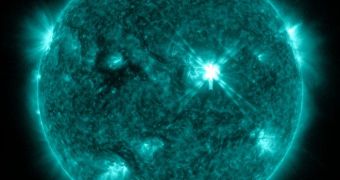As the Sun is approaching the peak of its current cycle, it is producing massive solar flares increasingly often. For the third time this year, an X-class event took place on the surface of the star. Just a few hours ahead, it was preceded by an M-class storm.
These instances of increased solar activity took place on Monday evening and Tuesday afternoon (EDT), and were separated by less than 24 hours. The first event was an M5-class solar storm, a classification that implies a medium-to-strong intensity.
This solar flare began occurring at around 9:50 pm EDT (0150 GMT Tuesday), and spawned a rather slow-moving coronal mass ejection (CME). Though less intense than its counterpart, it still lit up the detectors of solar telescopes monitoring the star.
The second event was a X2.1-class solar flare, which triggered a large CME that is oriented directly at our planet. X-class flares are the most powerful the Sun can produce, and they are usually take place in the years preceding and following the solar maximum.
The Sun operates in 11-year cycles, during which periods of low activity known as minimums alternate with times of great turmoil and solar flare production, called maximums. For the current cycle, the maximum is expected to occur around 2013.
What this means is that we can expect several more X-class flare being produced until the end of this year, and throughout 2012 and 2013. For 2011, solar physicists have already identified three such events, a higher number than expected.
The latest one started manifesting itself at 6:12 pm EDT (2212 GMT) yesterday, September 6, and reached peak intensity about 8 hours later. Experts at NASA and the US National Oceanic and Atmospheric Administration (NOAA) kept a close eye on its development.
The American space agency's Solar Dynamics Observatory (SDO) recorded high-definition videos of the event, which are now used to analyze its characteristics. In addition to this instrument, telescopes including SOHO, Hinode and STEREO also keep track of what goes on on the Sun.
At this point, it's still unclear whether the CME produced by the second solar flare will reach our planet, or if it is capable of causing any degree of damage if it does. However, experts are convinced that the plasma clouds will not be able to breach the magnetosphere if they get here.
Earth's magnetic shield is extremely well suited for dealing with such situations. It can deflect solar storms of high intensities, and it takes an uncommonly-intense solar flare to cause some of the radiation to pass through to the surface, Space reports.
“This CME is not expected to cause significant geomagnetic storm activity, and further analysis is currently underway to better refine the CME timing and magnitude,” NOAA Space Weather Prediction Center scientists wrote in an update published yesterday.

 14 DAY TRIAL //
14 DAY TRIAL //